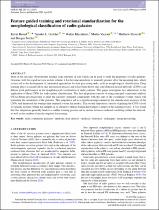| dc.contributor.author | Brand, Kevin | |
| dc.contributor.author | Grobler, Trienko L. | |
| dc.contributor.author | Prescott, Matthew | |
| dc.date.accessioned | 2023-05-30T07:27:11Z | |
| dc.date.available | 2023-05-30T07:27:11Z | |
| dc.date.issued | 2023 | |
| dc.identifier.citation | Brand, K. et al. (2023). Feature guided training and rotational standardization for the morphological classification of radio galaxies. Monthly Notices of the Royal Astronomical Society, 522(1), 292-311. https://doi.org/10.1093/mnras/stad989 | en_US |
| dc.identifier.issn | 1365-2966 | |
| dc.identifier.uri | https://doi.org/10.1093/mnras/stad989 | |
| dc.identifier.uri | http://hdl.handle.net/10566/8955 | |
| dc.description.abstract | State-of-the-art radio observatories produce large amounts of data which can be used to study the properties of radio galaxies.
However, with this rapid increase in data volume, it has become unrealistic to manually process all of the incoming data, which
in turn led to the development of automated approaches for data processing tasks, such as morphological classification. Deep
learning plays a crucial role in this automation process and it has been shown that convolutional neural networks (CNNs) can
deliver good performance in the morphological classification of radio galaxies. This paper investigates two adaptations to the
application of these CNNs for radio galaxy classification. The first adaptation consists of using principal component analysis
(PCA) during pre-processing to align the galaxies’ principal components with the axes of the coordinate system, which will
normalize the orientation of the galaxies. This adaptation led to a significant improvement in the classification accuracy of the
CNNs and decreased the average time required to train the models. The second adaptation consists of guiding the CNN to look
for specific features within the samples in an attempt to utilize domain knowledge to improve the training process. It was found
that this adaptation generally leads to a stabler training process and in certain instances reduced overfitting within the network,
as well as the number of epochs required for training. | en_US |
| dc.language.iso | en | en_US |
| dc.publisher | Oxford University Press | en_US |
| dc.subject | Physics | en_US |
| dc.subject | Astronomy | en_US |
| dc.subject | Galaxies | en_US |
| dc.subject | Statistics studies | en_US |
| dc.subject | Image processing | en_US |
| dc.title | Feature guided training and rotational standardization for the morphological classification of radio galaxies | en_US |
| dc.type | Article | en_US |

